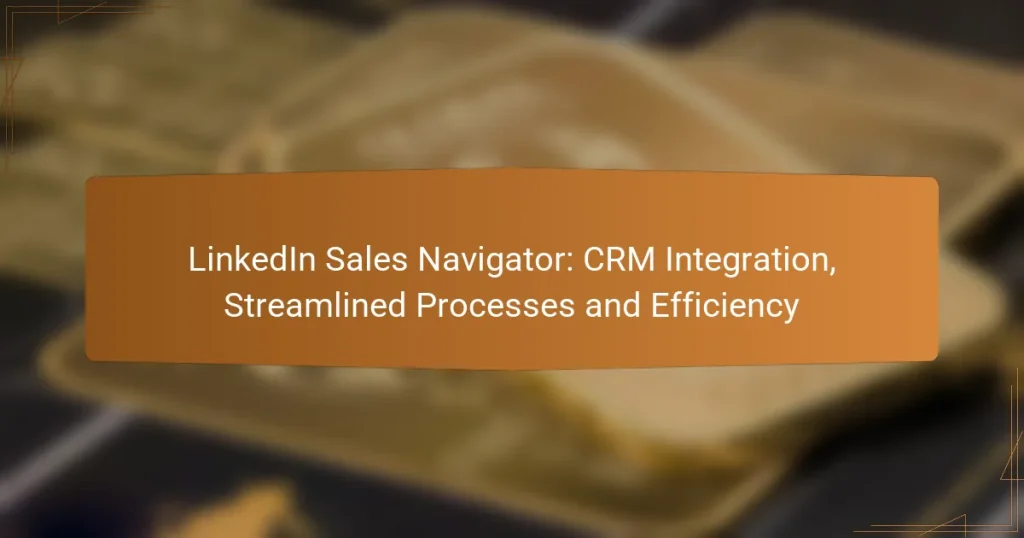LinkedIn Sales Navigator is a powerful tool designed to enhance lead generation and account management for sales professionals. With advanced features such as account and lead tracking, custom lists, and tailored sales preferences, it streamlines the process of identifying and connecting with potential clients. By leveraging LinkedIn’s extensive professional network, Sales Navigator provides unique capabilities that significantly improve sales efficiency and effectiveness.
LinkedIn Sales Navigator: TeamLink Networking and Collaboration
LinkedIn Sales Navigator: Real-Time Insights, Alerts and Decision Making
LinkedIn Sales Navigator: InMail Effectiveness, Advanced Features and Strategies
LinkedIn Sales Navigator: Marketing Automation Integration and Sales Alignment
LinkedIn Sales Navigator: Account Insights Benefits and Value
LinkedIn Sales Navigator: Advanced Search Filters, Lead Generation and Targeting
How can LinkedIn Sales Navigator enhance lead generation?
LinkedIn Sales Navigator enhances lead generation by providing advanced tools and features that help sales professionals identify and connect with potential clients more effectively. Its capabilities streamline the process of finding qualified leads, ultimately increasing sales opportunities.
Advanced search filters
Advanced search filters in LinkedIn Sales Navigator allow users to narrow down their lead searches based on specific criteria such as industry, company size, geography, and job title. This targeted approach increases the likelihood of finding leads that fit your ideal customer profile.
Utilizing these filters effectively can save time and improve the quality of your outreach. For example, you can filter for decision-makers in tech companies located in the European Union, ensuring your efforts are focused on the most relevant prospects.
Lead recommendations
Sales Navigator offers personalized lead recommendations based on your preferences and past interactions. This feature uses algorithms to suggest potential leads that align with your business goals, making it easier to discover new opportunities.
Regularly reviewing these recommendations can help you stay ahead of market trends and identify emerging prospects. It’s advisable to engage with these leads promptly to maximize your chances of conversion.
Integration with CRM systems
Integrating LinkedIn Sales Navigator with your CRM system enhances lead management by syncing data and providing a comprehensive view of your interactions. This integration allows for seamless tracking of leads and activities, ensuring no opportunities are missed.
Consider using popular CRM platforms like Salesforce or HubSpot, which offer direct integration with Sales Navigator. This connection can streamline workflows and improve overall efficiency in managing sales processes.
InMail messaging capabilities
InMail messaging allows users to send direct messages to prospects who are not in their network, significantly expanding outreach possibilities. This feature is particularly useful for initiating conversations with high-value leads who may not respond to traditional email outreach.
To increase the effectiveness of your InMail messages, personalize your outreach by referencing common connections or shared interests. Aim for concise and engaging messages to capture the recipient’s attention quickly.
Real-time insights
Real-time insights provided by LinkedIn Sales Navigator help users stay informed about changes in their leads’ activities, such as job changes or company news. This information can be leveraged to tailor your approach and engage leads at the right moment.
Utilizing these insights can enhance your follow-up strategies and improve your chances of conversion. Regularly check for updates on your leads to maintain relevance in your communications.
What are the key features of LinkedIn Sales Navigator?
LinkedIn Sales Navigator offers advanced tools designed to enhance lead generation and account management for sales professionals. Key features include account and lead tracking, custom lists, and sales preferences, all aimed at improving sales efficiency and effectiveness.
Account and lead tracking
Account and lead tracking in LinkedIn Sales Navigator allows users to monitor interactions and updates related to specific accounts and leads. This feature provides real-time insights, enabling sales teams to stay informed about changes in their prospects’ activities, such as job changes or company news.
To effectively utilize this feature, regularly review your tracked accounts and leads. Set reminders for follow-ups based on their activity, ensuring timely engagement. Avoid overwhelming yourself by focusing on a manageable number of key accounts that align with your sales goals.
Custom lists
Custom lists enable users to organize leads and accounts based on specific criteria, making it easier to segment and prioritize outreach efforts. You can create lists based on industry, company size, or geographic location, tailoring your approach to different market segments.
When creating custom lists, consider using tags to categorize leads by their stage in the sales funnel. This practice helps streamline your sales process and ensures that you are targeting the right prospects at the right time. Regularly update these lists to reflect changes in your sales strategy or market conditions.
Sales preferences
Sales preferences allow users to customize their experience within LinkedIn Sales Navigator, tailoring the platform to their specific sales needs. This feature includes setting preferences for lead recommendations, alerts, and search filters, ensuring that you receive the most relevant information.
To maximize the effectiveness of sales preferences, take time to adjust your settings based on your target audience and sales objectives. Regularly revisit these preferences to adapt to evolving market trends or changes in your business strategy. Avoid rigid settings that may limit your exposure to new opportunities.
How does LinkedIn Sales Navigator compare to other tools?
LinkedIn Sales Navigator stands out among sales tools for its robust integration with LinkedIn’s vast professional network. It offers unique features tailored for lead generation and relationship building that may not be as comprehensive in other platforms.
Comparison with HubSpot Sales
LinkedIn Sales Navigator and HubSpot Sales both aim to enhance sales processes but differ significantly in their approaches. While HubSpot provides a full CRM solution with marketing automation, LinkedIn Sales Navigator focuses primarily on social selling and lead discovery within LinkedIn’s ecosystem.
For example, HubSpot Sales offers email tracking and pipeline management, which are essential for nurturing leads. In contrast, LinkedIn Sales Navigator excels in advanced search capabilities and personalized outreach through InMail, making it ideal for connecting with potential clients directly.
Comparison with ZoomInfo
ZoomInfo and LinkedIn Sales Navigator serve similar purposes in lead generation but utilize different data sources and methodologies. ZoomInfo specializes in providing detailed company and contact information, which can be beneficial for targeted outreach.
On the other hand, LinkedIn Sales Navigator leverages real-time updates from LinkedIn profiles, allowing users to engage with leads based on their current activities and interests. This dynamic approach can lead to more meaningful interactions, whereas ZoomInfo’s static data may require more frequent updates to remain relevant.
What are the pricing options for LinkedIn Sales Navigator?
LinkedIn Sales Navigator offers flexible pricing options to cater to different user needs, primarily through monthly and annual subscriptions. These plans provide access to various advanced features that enhance lead generation and sales prospecting.
Monthly subscription costs
The monthly subscription for LinkedIn Sales Navigator typically ranges from approximately $80 to $100 per month, depending on the specific plan chosen. This option allows users to pay on a month-to-month basis, which can be beneficial for those who need temporary access or want to test the platform before committing long-term.
Keep in mind that the monthly cost may vary based on promotions or regional pricing differences. It’s advisable to check LinkedIn’s official website for the most current pricing details.
Annual subscription discounts
Opting for an annual subscription can lead to significant savings, with discounts often ranging from 15% to 20% compared to the monthly rate. This makes the annual plan a cost-effective choice for businesses planning to use Sales Navigator over a longer period.
When considering the annual subscription, evaluate your usage needs and ensure that the investment aligns with your sales goals. The upfront payment may be higher, but the long-term savings can be substantial.
What are the prerequisites for using LinkedIn Sales Navigator?
To effectively use LinkedIn Sales Navigator, you need a LinkedIn Premium account and a solid understanding of your target audience. These prerequisites ensure you can leverage the platform’s advanced features to maximize your sales efforts.
LinkedIn Premium account
A LinkedIn Premium account is essential for accessing Sales Navigator. This subscription unlocks advanced search filters, lead recommendations, and insights that are not available with a free account. Pricing for Premium accounts typically ranges from around $30 to $100 per month, depending on the plan you choose.
When selecting a Premium plan, consider your specific needs. For instance, if you primarily focus on sales, the Sales Navigator plan offers tailored features that enhance lead generation and relationship management. Always evaluate the return on investment based on your sales goals.
Understanding of target audience
Having a clear understanding of your target audience is crucial when using LinkedIn Sales Navigator. This knowledge allows you to effectively utilize the platform’s advanced search capabilities to identify potential leads that align with your business objectives. Define key characteristics such as industry, company size, and job titles to refine your search.
To enhance your targeting, create buyer personas that represent your ideal customers. This practice helps you tailor your outreach strategies and messaging, increasing the likelihood of successful connections. Regularly update your understanding of your audience as market dynamics change, ensuring your approach remains relevant.
How can businesses maximize LinkedIn Sales Navigator’s features?
Businesses can maximize LinkedIn Sales Navigator’s features by leveraging its advanced search capabilities, personalized recommendations, and integration with CRM systems. By utilizing these tools effectively, companies can enhance their lead generation and sales processes significantly.
Utilizing training resources
LinkedIn offers a variety of training resources to help users fully understand and utilize Sales Navigator. These include webinars, tutorials, and an extensive help center that covers everything from basic navigation to advanced strategies.
Taking advantage of these resources can lead to better usage of the platform. For instance, participating in live training sessions can provide insights into best practices and tips from experienced users, which can be directly applied to improve lead generation efforts.
Setting clear lead generation goals
Establishing clear lead generation goals is crucial for maximizing the effectiveness of LinkedIn Sales Navigator. Businesses should define specific metrics, such as the number of leads to generate per month or the target conversion rate, to guide their efforts.
For example, a business might aim to connect with 50 new prospects each week or increase their response rate by 20% over the next quarter. These goals should be regularly reviewed and adjusted based on performance data to ensure continuous improvement and alignment with overall sales objectives.






